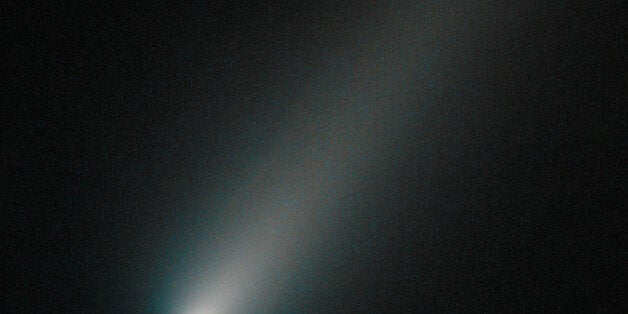
NASA image use policy.NASA Goddard Space Flight Center enables NASA?s mission through four scientific endeavors: Earth Science, Heliophysics, Solar System Exploration, and Astrophysics. Goddard plays a leading role in NASA?s accomplishments by contributing compelling scientific knowledge to advance the Agency?s mission.Follow us on TwitterLike us on FacebookFind us on Instagram" data-caption="A new image of the sunward plunging Comet ISON suggests that the comet is intact despite some predictions that the fragile icy nucleus might disintegrate as the Sun warms it. The comet will pass closest to the Sun on November 28.In this NASA Hubble Space Telescope image taken on October 9, the comet's solid nucleus is unresolved because it is so small. If the nucleus broke apart then Hubble would have likely seen evidence for multiple fragments.Moreover, the coma or head surrounding the comet's nucleus is symmetric and smooth. This would probably not be the case if clusters of smaller fragments were flying along. A polar jet of dust first seen in Hubble images taken in April is no longer visible and may have turned off.This color composite image was assembled using two filters. The comet's coma appears cyan, a greenish-blue color due to gas, while the tail is reddish due to dust streaming off the nucleus. The tail forms as dust particles are pushed away from the nucleus by the pressure of sunlight. The comet was inside Mars' orbit and 177 million miles from Earth when photographed. Comet ISON is predicted to make its closest approach to Earth on December 26, at a distance of 39.9 million miles.Credit: NASA, ESA, and the Hubble Heritage Team (STScI/AURA)NASA image use policy.NASA Goddard Space Flight Center enables NASA?s mission through four scientific endeavors: Earth Science, Heliophysics, Solar System Exploration, and Astrophysics. Goddard plays a leading role in NASA?s accomplishments by contributing compelling scientific knowledge to advance the Agency?s mission.Follow us on TwitterLike us on FacebookFind us on Instagram" data-credit="NASA Goddard Photo and Video/Flickr">
Comet ISON, the 'comet of the century', has suddenly ignited and is now visible to the naked eye.
Astronomers have confirmed that the potentially staggering comet has massively increased in brightness in recent days and can now be seen without the aid of a telescope or binoculars - if you know where to look.
Check out our guide on how to see the comet if you want to get a good look this weekend.
Space.com reported that the comet is now in "full outburst mode" having increased in brightness by a magnitude of two in just 24 hours. It's now within the threshold of being visible to the naked eye in the night sky.
In 72 hours the comet has increased in brightness by a factor of 16.
The comet is now approaching the surface of the Sun, and could potentially brighten every day until the end of November - that is if it doesn't fall apart or explode before then.
If it lasts, the comet could shine as brightly as the Moon - or brighter - in the night sky, and could even be visible during the day.
Veteran comet hunter John Bortle told Space.com: "I couldn't figure out what the funny-looking, blotted, star that came into view was. [Was my] seeing that bad? But, no, the 'blotted star' was, in fact, at the comet's position!"
It's not currently known if the comet will continue to brighten. It has fluctuated in brightness before - though never to this extent. Astronomers now hope we could be on the verge of something spectacular...